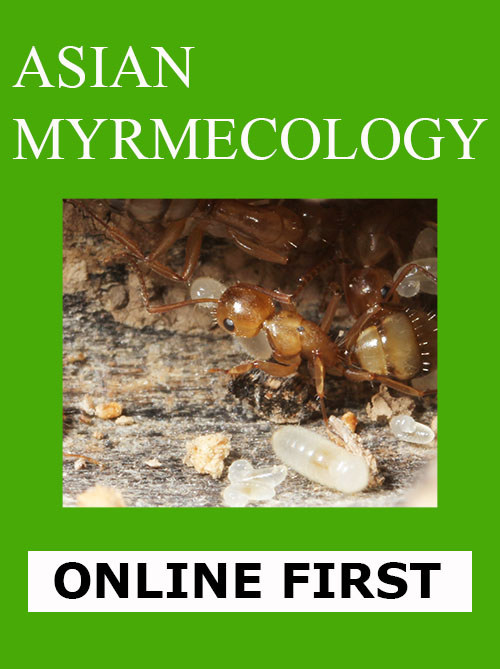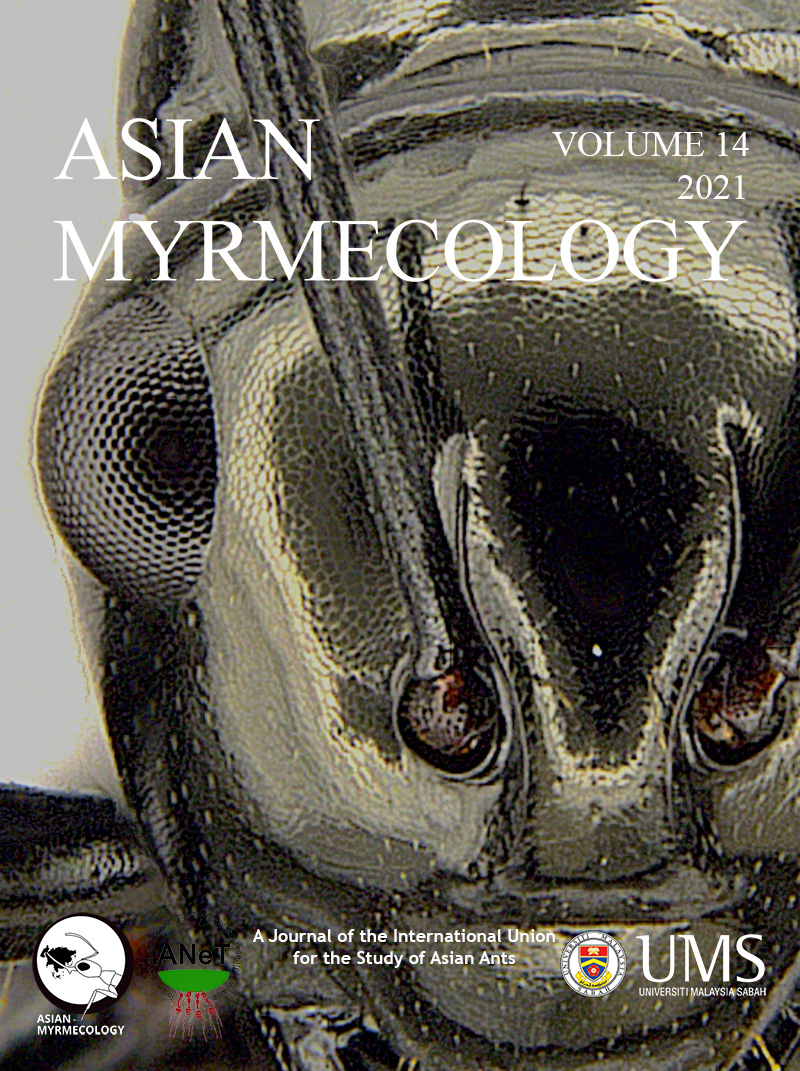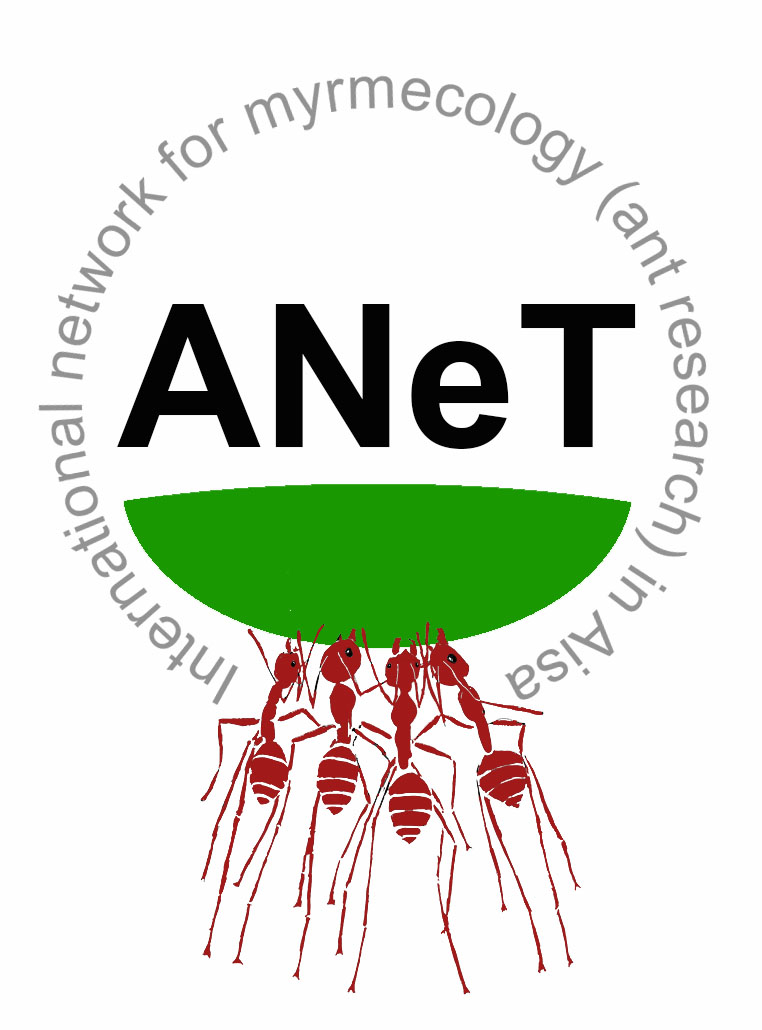ASIAN
MYRMECOLOGY
Image: François Brassard
DOI: 10.20362/am.016009
Asian Myrmecology 16: 016009 (1-15)
article first published online: 11/December/2023
Natural history notes of the rare enigmatic ant Opamyrma hungvuong: A first glimpse of their preying behavior on centipedes (Hymenoptera: Formicidae: Leptanillinae)
AIKI YAMADA1*, AN VAN DANG2 & KATSUYUKI EGUCHI1,3
Abstract:
Opamyrma hungvuong Yamane, Bui & Eguchi, 2008, represents the earliest branching extant leptanilline lineage, whose biology is largely unknown. Although preliminary and fragmentary, as we were only able to observe them for a short period of time between March 18–23, 2023, we report here the first observations on the biology of the species in captivity, focusing on their preying behavior on centipedes. We captured two colonies (possibly fragments, containing several or many alate and dealate queens and no immatures) and a solitary dealate queen of O. hungvuong in Pu Hoat Nature Reserve, Nghe An, Vietnam. We could not confirm whether the two colonies contained mated reproductive queens and whether the solitary dealate queen was mated. We observed their reactions by offering some centipedes and juliform millipedes. Individuals from the colonies ignored juvenile juliform millipedes but readily paralyzed a geophilomorph (Mecistocephalus sp.), a lithobiomorph (Lithobius sp.), and two juvenile scolopendromorph centipedes (Scolopocryptops sp.) by stinging. Not only workers but also alate and dealate queens in the colonies aggressively attacked the centipedes. However, they failed to hunt a linotaeniid geophilomorph centipede (Strigamia sp.); the ants were quickly killed probably due to the chemical defense of the centipede. The solitary dealate queen also readily paralyzed a Scolopocryptops juvenile by sophisticated hunting behavior. The workers and dealate queens of O. hungvuong showed eager (apparently hemolymph) licking behavior on the paralyzed Mecistocephalus centipede. Our observations indicate that O. hungvuong is well-adapted for preying on certain active centipedes, although their exact prey repertoire and degree of prey specialization remain uncertain. Some other notes on their habitat, ovariole number, venom apparatus, and unique metasomal habitus are provided. We also discuss the functional roles of some female caste morphologies of O. hungvuong in their centipede hunting.
Keywords:
Chilopoda, chemical defense, Leptanillomorpha, predator-prey interaction, subterranean
Get PDF (3.9 MB) :
AIKI YAMADA1*, AN VAN DANG2 & KATSUYUKI EGUCHI1,3
Abstract:
Opamyrma hungvuong Yamane, Bui & Eguchi, 2008, represents the earliest branching extant leptanilline lineage, whose biology is largely unknown. Although preliminary and fragmentary, as we were only able to observe them for a short period of time between March 18–23, 2023, we report here the first observations on the biology of the species in captivity, focusing on their preying behavior on centipedes. We captured two colonies (possibly fragments, containing several or many alate and dealate queens and no immatures) and a solitary dealate queen of O. hungvuong in Pu Hoat Nature Reserve, Nghe An, Vietnam. We could not confirm whether the two colonies contained mated reproductive queens and whether the solitary dealate queen was mated. We observed their reactions by offering some centipedes and juliform millipedes. Individuals from the colonies ignored juvenile juliform millipedes but readily paralyzed a geophilomorph (Mecistocephalus sp.), a lithobiomorph (Lithobius sp.), and two juvenile scolopendromorph centipedes (Scolopocryptops sp.) by stinging. Not only workers but also alate and dealate queens in the colonies aggressively attacked the centipedes. However, they failed to hunt a linotaeniid geophilomorph centipede (Strigamia sp.); the ants were quickly killed probably due to the chemical defense of the centipede. The solitary dealate queen also readily paralyzed a Scolopocryptops juvenile by sophisticated hunting behavior. The workers and dealate queens of O. hungvuong showed eager (apparently hemolymph) licking behavior on the paralyzed Mecistocephalus centipede. Our observations indicate that O. hungvuong is well-adapted for preying on certain active centipedes, although their exact prey repertoire and degree of prey specialization remain uncertain. Some other notes on their habitat, ovariole number, venom apparatus, and unique metasomal habitus are provided. We also discuss the functional roles of some female caste morphologies of O. hungvuong in their centipede hunting.
Keywords:
Chilopoda, chemical defense, Leptanillomorpha, predator-prey interaction, subterranean
Get PDF (3.9 MB) :
Get Supplementary Figure S1 (png) (10 MB) :
Get Supplementary Video 1 (mp4) (103 MB) :
Get Supplementary Video 2 (mp4) (111 MB) :
Get Supplementary Video 3 (mp4) (85 MB) :
1Systematic Zoology Laboratory, Department of Biological Sciences, Graduate School of Science, Tokyo Metropolitan University, 1-1 Minami-Osawa, Hachioji, Tokyo, 192-0397, Japan
2Institute of Ecology and Biological Resources, Vietnam Academy of Science and Technology, 18 Hoang Quoc Viet Road, Cau Giay District, Hanoi, Vietnam
3Department of International Health and Medical Anthropology, Institute of Tropical Medicine, Nagasaki University, 1-12-4 Sakamoto, Nagasaki, Nagasaki, 852-8523, Japan
*Corresponding author: aiki.ymd@gmail.com



